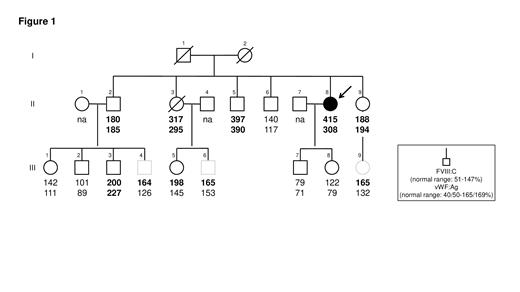Background: High levels of factor VIII (FVIII) and von Willebrand factor (vWF) have been indicated as independent risk factors for venous thromboembolism. However, the genetic factors responsible for their increase remain still poorly known. In a woman referred to our Thrombosis unit following a venous thrombotic event, very high levels of FVIII and vWF were found at the acute episode and in subsequent measurements. High levels of FVIII and vWF were also detected in other family members, suggesting a possible genetic cause (Figure 1).
Aim: To identify variants/genes associated with high levels of FVIII and vWF.
Methods: In a large Italian family with high levels of FVIII/vWF and thrombotic episodes, whole-exome sequencing was performed in 12 family members (SureSelect-Agilent). Data were analyzed according to the guidelines of the Broad Institute (https://software.broadinstitute.org/gatk/best-practices/). Variants were annotated (Annovar) and filtered (KGGseq) according to an autosomal dominant inheritance model of high levels of FVIII or vWF. RNA levels were evaluated in PBMCs by qPCR (Thermo Fisher).
Results: 20 variants, spread over a 8300-Kb region on chromosome 5, were identified in 12 genes, including the low frequency rs13158382 located upstream of the MIR143/145 genes. Since variants in the promoter of MIR143/145 have been reported to affect their expression and reduced levels of miR-145 have been associated with high vWF, the potential correlation between rs13158382 and vWF levels was evaluated. Lower levels of both miRNAs and higher level of vWF mRNA were measured in family members carrying the variant (n=3) compared to family members without the variant (n=3). Analysis of genetic and expression data from of a larger cohort of individuals from the 1000 Genomes and GEUVADIS project confirmed a statistically significant reduction (p=0.023) of miR-143 in heterozygous subjects (n=35) compared to homozygous wild-type individuals (n=386). Since low levels of pri-miRNA-143/145 were measured in heterozygous family members and structural changes of pre-miR-143 with rs13158382 was predicted by miRVaS tool, the reduction of mature miRNAs might result from a lowered synthesis of pri-miRNAs and/or from an aberrant processing of pre-miRNA.
Conclusion: This family-based study revealed a new genetic variant potentially involved in vWF increase by reducing the expression of miR-143/145.
Disclosures
Peyvandi:Biomarin: Membership on an entity's Board of Directors or advisory committees; Sanofi: Membership on an entity's Board of Directors or advisory committees; Sobi: Membership on an entity's Board of Directors or advisory committees; CSL Behring: Membership on an entity's Board of Directors or advisory committees; Roche: Membership on an entity's Board of Directors or advisory committees; Spark: Speakers Bureau; Takeda: Speakers Bureau.


